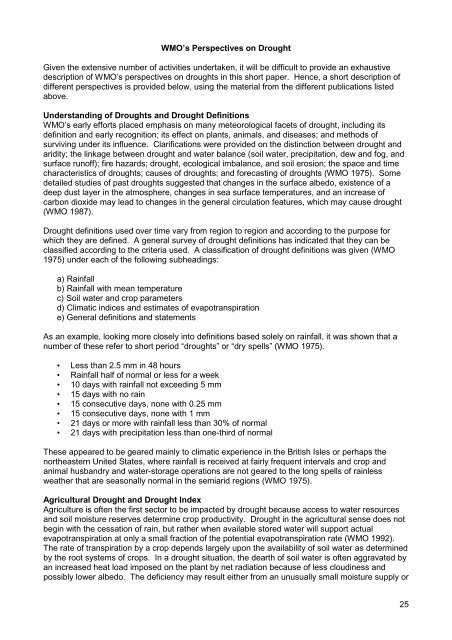Agricultural Drought Indices - US Department of Agriculture
Agricultural Drought Indices - US Department of Agriculture
Agricultural Drought Indices - US Department of Agriculture
You also want an ePaper? Increase the reach of your titles
YUMPU automatically turns print PDFs into web optimized ePapers that Google loves.
WMO’s Perspectives on <strong>Drought</strong><br />
Given the extensive number <strong>of</strong> activities undertaken, it will be difficult to provide an exhaustive<br />
description <strong>of</strong> WMO’s perspectives on droughts in this short paper. Hence, a short description <strong>of</strong><br />
different perspectives is provided below, using the material from the different publications listed<br />
above.<br />
Understanding <strong>of</strong> <strong>Drought</strong>s and <strong>Drought</strong> Definitions<br />
WMO’s early efforts placed emphasis on many meteorological facets <strong>of</strong> drought, including its<br />
definition and early recognition; its effect on plants, animals, and diseases; and methods <strong>of</strong><br />
surviving under its influence. Clarifications were provided on the distinction between drought and<br />
aridity; the linkage between drought and water balance (soil water, precipitation, dew and fog, and<br />
surface run<strong>of</strong>f); fire hazards; drought, ecological imbalance, and soil erosion; the space and time<br />
characteristics <strong>of</strong> droughts; causes <strong>of</strong> droughts; and forecasting <strong>of</strong> droughts (WMO 1975). Some<br />
detailed studies <strong>of</strong> past droughts suggested that changes in the surface albedo, existence <strong>of</strong> a<br />
deep dust layer in the atmosphere, changes in sea surface temperatures, and an increase <strong>of</strong><br />
carbon dioxide may lead to changes in the general circulation features, which may cause drought<br />
(WMO 1987).<br />
<strong>Drought</strong> definitions used over time vary from region to region and according to the purpose for<br />
which they are defined. A general survey <strong>of</strong> drought definitions has indicated that they can be<br />
classified according to the criteria used. A classification <strong>of</strong> drought definitions was given (WMO<br />
1975) under each <strong>of</strong> the following subheadings:<br />
a) Rainfall<br />
b) Rainfall with mean temperature<br />
c) Soil water and crop parameters<br />
d) Climatic indices and estimates <strong>of</strong> evapotranspiration<br />
e) General definitions and statements<br />
As an example, looking more closely into definitions based solely on rainfall, it was shown that a<br />
number <strong>of</strong> these refer to short period “droughts” or “dry spells” (WMO 1975).<br />
• Less than 2.5 mm in 48 hours<br />
• Rainfall half <strong>of</strong> normal or less for a week<br />
• 10 days with rainfall not exceeding 5 mm<br />
• 15 days with no rain<br />
• 15 consecutive days, none with 0.25 mm<br />
• 15 consecutive days, none with 1 mm<br />
• 21 days or more with rainfall less than 30% <strong>of</strong> normal<br />
• 21 days with precipitation less than one-third <strong>of</strong> normal<br />
These appeared to be geared mainly to climatic experience in the British Isles or perhaps the<br />
northeastern United States, where rainfall is received at fairly frequent intervals and crop and<br />
animal husbandry and water-storage operations are not geared to the long spells <strong>of</strong> rainless<br />
weather that are seasonally normal in the semiarid regions (WMO 1975).<br />
<strong>Agricultural</strong> <strong>Drought</strong> and <strong>Drought</strong> Index<br />
<strong>Agriculture</strong> is <strong>of</strong>ten the first sector to be impacted by drought because access to water resources<br />
and soil moisture reserves determine crop productivity. <strong>Drought</strong> in the agricultural sense does not<br />
begin with the cessation <strong>of</strong> rain, but rather when available stored water will support actual<br />
evapotranspiration at only a small fraction <strong>of</strong> the potential evapotranspiration rate (WMO 1992).<br />
The rate <strong>of</strong> transpiration by a crop depends largely upon the availability <strong>of</strong> soil water as determined<br />
by the root systems <strong>of</strong> crops. In a drought situation, the dearth <strong>of</strong> soil water is <strong>of</strong>ten aggravated by<br />
an increased heat load imposed on the plant by net radiation because <strong>of</strong> less cloudiness and<br />
possibly lower albedo. The deficiency may result either from an unusually small moisture supply or<br />
25

















